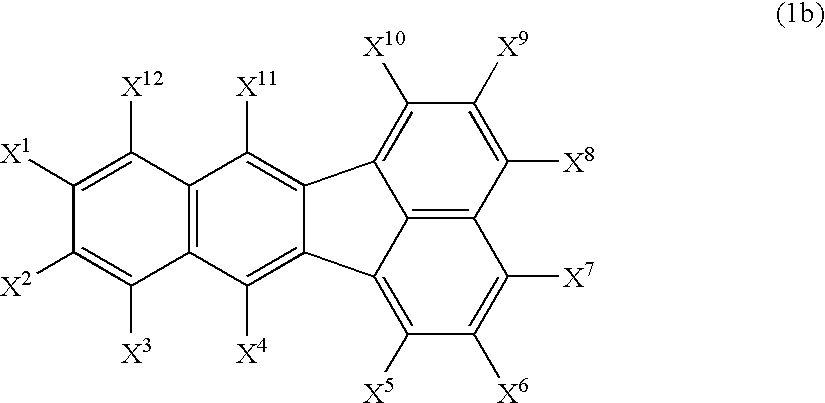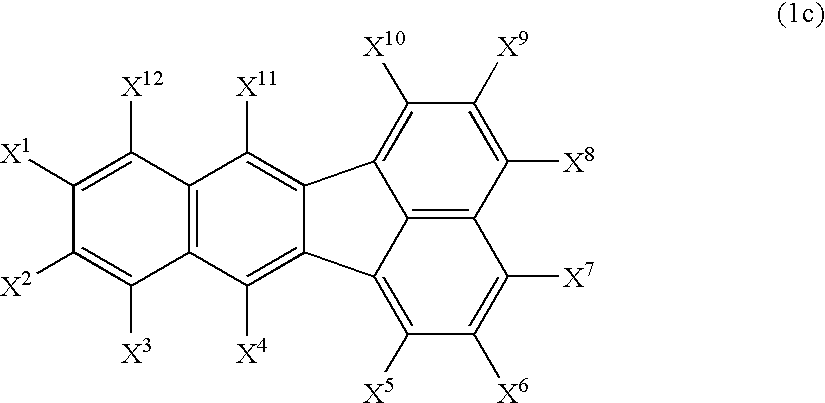Organic electroluminescence device
- Summary
- Abstract
- Description
- Claims
- Application Information
AI Technical Summary
Benefits of technology
Problems solved by technology
Method used
Image
Examples
example 1
[0247] (1) Production of Organic EL Device
[0248] A transparent electrode composed of an indium tin oxide and having a thickness of 120 nm was provided on a glass substrate measuring 25 mm wide by 75 mm long by 1.1 mm thick. The glass substrate was subjected to ultrasonic cleaning with isopropyl alcohol, and was then washed by being irradiated with ultraviolet light and ozone.
[0249] Next, the glass substrate provided with the transparent electrode was mounted on a substrate holder in the deposition tank of a vacuum deposition device, and the degree of vacuum in the vacuum tank was reduced to 1×10−3 Pa.
[0250] First, N′,N″-bis[4-(diphenylamino)phenyl]-N′,N″-diphenylbiphenyl-4,4′-diamine was formed into a film having a thickness of 60 nm at a deposition rate of 2 nm / sec on the surface on the side where the transparent electrode was formed so as to cover the transparent electrode. The film functions as a hole injecting layer.
[0251] Next, N,N-bis[4′-{N-(naphthyl-1-yl)-N-phenyl}aminobi...
examples 2 to 5
[0258] In each of Examples 2 to 5, an organic EL device was produced in the same manner as in Example 1 except the following: Compound (2a′-59) and Compound (1-3) were used in a light emitting layer at a weight ratio of 40:2 in Example 2, Compound (2a′-59) and Compound (1-7) were used in a light emitting layer at a weight ratio of 40:2 in Example 3, Compound (2a′-101) and Compound (1-79) were used in a light emitting layer at a weight ratio of 40:2 in Example 4, and Compound (2a-7) and Compound (1-27) were used in a light emitting layer at a weight ratio of 40:2 in Example 5 instead of Compound (2a′-55) and Compound (1-3) in Example 1.
[0259] As a result, as shown in Table 1, all the devices were each observed to emit blue light, and each had an emission luminance of 670 to 760 cd / m2 and a half lifetime of 10,000 hours or longer. The result means that all the devices were sufficient for practical use.
examples 6 to 10
[0260] In each of Examples 6 to 10, an organic EL device was produced in the same manner as in Example 1 except the following: Compound (2a′-57) and Compound (1-36) were used in a light emitting layer at a weight ratio of 40:2 in Example 6, Compound (2b-9) and Compound (1-5) were used in a light emitting layer at a weight ratio of 40:2 in Example 7, Compound (2b-26) and Compound (1-97) were used in a light emitting layer at a weight ratio of 40:2 in Example 8, Compound (2c-1) and Compound (1-8) were used in a light emitting layer at a weight ratio of 40:2 in Example 9, and Compound (2d-1) and Compound (1-3) were used in a light emitting layer at a weight ratio of 40:2 in Example 10 instead of Compound (2a′-55) and Compound (1-3) in Example 1.
[0261] As a result, as shown in Table 2, all the devices were each observed to emit blue light, and each had an emission luminance of 675 to 710 cd / m2 and a half lifetime of 10,000 hours or longer. The result means that all the devices were suf...
PUM
| Property | Measurement | Unit |
|---|---|---|
| Time | aaaaa | aaaaa |
| Luminous efficiency | aaaaa | aaaaa |
Abstract
Description
Claims
Application Information
 Login to View More
Login to View More - R&D
- Intellectual Property
- Life Sciences
- Materials
- Tech Scout
- Unparalleled Data Quality
- Higher Quality Content
- 60% Fewer Hallucinations
Browse by: Latest US Patents, China's latest patents, Technical Efficacy Thesaurus, Application Domain, Technology Topic, Popular Technical Reports.
© 2025 PatSnap. All rights reserved.Legal|Privacy policy|Modern Slavery Act Transparency Statement|Sitemap|About US| Contact US: help@patsnap.com



